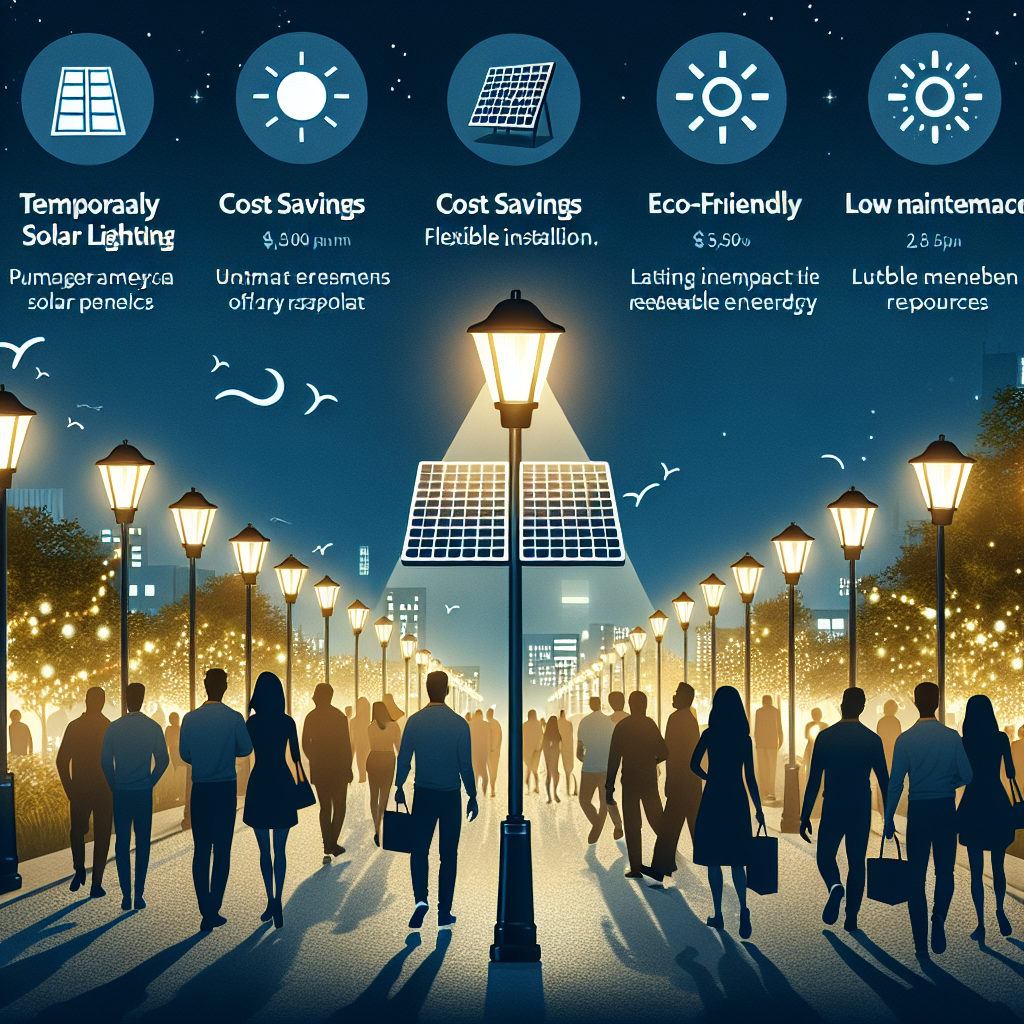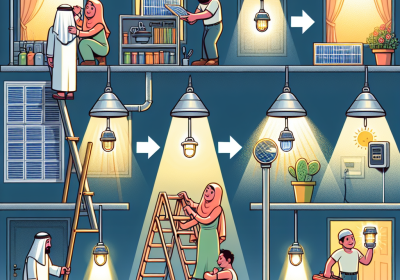Advantages of Temporary Solar Lighting
-
Table of Contents
Temporary solar lighting offers numerous advantages, making it an increasingly popular choice for various applications. One of the primary benefits is its sustainability; powered by renewable solar energy, it reduces reliance on fossil fuels and minimizes carbon emissions. This eco-friendly solution is also cost-effective, as it eliminates the need for extensive wiring and reduces electricity bills. Additionally, temporary solar lighting is highly versatile and portable, making it ideal for events, construction sites, and emergency situations where traditional lighting infrastructure may be impractical or unavailable. Its ease of installation and low maintenance requirements further enhance its appeal, providing a reliable and efficient lighting solution that can be quickly deployed and easily relocated as needed.
Cost-Effective Solutions For Short-Term Projects
Temporary solar lighting offers a multitude of advantages, particularly when it comes to cost-effective solutions for short-term projects. One of the primary benefits is the significant reduction in energy costs. Unlike traditional lighting systems that rely on electricity from the grid, solar lighting harnesses energy from the sun, which is both abundant and free. This eliminates the need for expensive electrical installations and ongoing utility bills, making it an economically viable option for projects with limited budgets.
Moreover, the installation process for temporary solar lighting is relatively straightforward and quick. Traditional lighting systems often require extensive wiring and trenching, which can be both time-consuming and costly. In contrast, solar lighting systems are typically designed to be plug-and-play, requiring minimal setup. This ease of installation not only reduces labor costs but also minimizes disruptions to the project timeline, allowing for faster deployment and completion.
In addition to cost savings and ease of installation, temporary solar lighting is also highly versatile. These systems can be easily relocated and adjusted to meet the changing needs of a project. For instance, construction sites, outdoor events, and emergency response situations often require flexible lighting solutions that can be moved as the project progresses or as circumstances change. Solar lighting units can be quickly repositioned without the need for extensive reconfiguration, providing a level of adaptability that traditional lighting systems cannot match.
Furthermore, temporary solar lighting is an environmentally friendly option. By utilizing renewable energy, these systems reduce the carbon footprint associated with traditional lighting methods. This is particularly important in today’s context, where there is a growing emphasis on sustainability and reducing environmental impact. Companies and organizations that opt for solar lighting can demonstrate their commitment to green practices, which can enhance their reputation and appeal to environmentally conscious stakeholders.
Another advantage of temporary solar lighting is its reliability in remote or off-grid locations. In areas where access to the electrical grid is limited or non-existent, solar lighting provides a dependable source of illumination. This is especially beneficial for projects in rural or undeveloped regions, where traditional lighting infrastructure may be lacking. Solar lighting systems are designed to store energy during the day and provide consistent lighting throughout the night, ensuring that work can continue uninterrupted regardless of location.
Additionally, temporary solar lighting systems often come equipped with advanced features such as motion sensors, timers, and remote monitoring capabilities. These features enhance the functionality and efficiency of the lighting system, allowing for better control and management. For example, motion sensors can help conserve energy by activating the lights only when movement is detected, while remote monitoring allows for real-time oversight and adjustments, ensuring optimal performance.
In conclusion, temporary solar lighting presents a cost-effective and versatile solution for short-term projects. Its ability to reduce energy costs, ease of installation, adaptability, environmental benefits, reliability in remote locations, and advanced features make it an attractive option for a wide range of applications. As the demand for sustainable and efficient lighting solutions continues to grow, temporary solar lighting is poised to play an increasingly important role in meeting the needs of various industries and sectors.
Easy Installation And Mobility

Temporary solar lighting offers numerous advantages, particularly in terms of easy installation and mobility. These benefits make it an attractive option for a variety of applications, ranging from construction sites to outdoor events. One of the primary advantages of temporary solar lighting is its straightforward installation process. Unlike traditional lighting systems that require extensive wiring and electrical work, solar lighting units are typically self-contained. This means that they come with built-in solar panels, batteries, and LED lights, which can be set up quickly and with minimal effort. Consequently, this ease of installation reduces the need for specialized labor and decreases the overall setup time.
Moreover, the mobility of temporary solar lighting is another significant benefit. These units are designed to be portable, allowing them to be easily moved from one location to another as needed. This is particularly useful in dynamic environments where lighting requirements may change frequently. For instance, construction sites often need to adjust their lighting as the project progresses and different areas require illumination. With temporary solar lighting, workers can simply relocate the units without the hassle of rewiring or reconfiguring electrical systems. This flexibility not only saves time but also enhances operational efficiency.
In addition to easy installation and mobility, temporary solar lighting is also environmentally friendly. By harnessing the power of the sun, these units reduce reliance on fossil fuels and decrease greenhouse gas emissions. This aligns with global efforts to combat climate change and promotes sustainable practices. Furthermore, solar lighting systems typically have lower operating costs compared to traditional lighting solutions. Since they rely on renewable energy, there are no ongoing electricity expenses, making them a cost-effective option in the long run.
Another advantage of temporary solar lighting is its reliability in remote or off-grid locations. In areas where access to the electrical grid is limited or nonexistent, solar lighting provides a viable solution. This is particularly beneficial for outdoor events, emergency response situations, and rural development projects. The ability to deploy lighting quickly and efficiently in these contexts can significantly improve safety and productivity. Additionally, many temporary solar lighting units are designed to withstand harsh weather conditions, ensuring consistent performance even in challenging environments.
Furthermore, the technological advancements in solar lighting have led to improved efficiency and functionality. Modern solar lighting units are equipped with high-efficiency solar panels and long-lasting batteries, which enhance their performance and extend their operational life. Some units also come with smart features, such as motion sensors and remote control capabilities, allowing for more precise and energy-efficient lighting management. These innovations contribute to the overall effectiveness and appeal of temporary solar lighting solutions.
In conclusion, the advantages of temporary solar lighting, particularly in terms of easy installation and mobility, make it a highly practical and versatile option for various applications. Its environmental benefits, cost-effectiveness, and reliability in remote locations further enhance its appeal. As technology continues to advance, the efficiency and functionality of solar lighting systems are expected to improve, solidifying their position as a preferred choice for temporary lighting needs.
Environmental Benefits And Sustainability
Temporary solar lighting offers a myriad of environmental benefits and contributes significantly to sustainability efforts. As the world grapples with the pressing need to reduce carbon emissions and mitigate climate change, the adoption of renewable energy sources has become paramount. Solar lighting, particularly in its temporary form, stands out as a practical and eco-friendly solution that aligns with these global objectives.
One of the primary environmental benefits of temporary solar lighting is its ability to reduce greenhouse gas emissions. Traditional lighting systems, which rely heavily on fossil fuels, contribute significantly to carbon dioxide emissions. In contrast, solar lighting harnesses energy from the sun, a renewable and inexhaustible resource. By converting sunlight into electricity, solar lighting systems eliminate the need for fossil fuels, thereby reducing the carbon footprint associated with lighting. This reduction in greenhouse gas emissions is crucial in the fight against climate change, as it helps to slow the warming of the planet and mitigate its adverse effects.
Moreover, temporary solar lighting systems are designed to be highly energy-efficient. They utilize advanced photovoltaic technology to maximize the conversion of sunlight into usable energy. This efficiency not only ensures that the lighting systems operate effectively but also minimizes energy wastage. In addition, many temporary solar lighting solutions are equipped with energy storage capabilities, allowing them to store excess energy generated during the day for use at night or during periods of low sunlight. This feature enhances their reliability and ensures a consistent supply of clean energy, further reducing the reliance on non-renewable energy sources.
Another significant advantage of temporary solar lighting is its minimal environmental impact during installation and operation. Traditional lighting systems often require extensive infrastructure, including wiring and trenching, which can disrupt natural habitats and ecosystems. In contrast, temporary solar lighting systems are typically easy to install and require minimal groundwork. They can be deployed quickly and without the need for extensive construction, thereby preserving the natural environment. Additionally, because they are temporary, these systems can be easily relocated or removed without leaving a lasting impact on the landscape.
Temporary solar lighting also promotes sustainability by reducing the demand for finite resources. The production and maintenance of traditional lighting systems often involve the extraction and consumption of raw materials, such as metals and plastics. These processes can deplete natural resources and generate significant amounts of waste. Solar lighting systems, on the other hand, are designed to be durable and require minimal maintenance. The use of high-quality materials and advanced manufacturing techniques ensures that these systems have a long lifespan, reducing the need for frequent replacements and minimizing waste generation.
Furthermore, the adoption of temporary solar lighting can have a positive ripple effect on local communities and economies. By reducing energy costs and dependence on non-renewable energy sources, communities can allocate resources to other essential services and initiatives. Additionally, the deployment of solar lighting systems can create job opportunities in the renewable energy sector, fostering economic growth and development. This, in turn, supports the broader goal of sustainable development, which seeks to balance economic, social, and environmental objectives.
In conclusion, temporary solar lighting offers numerous environmental benefits and contributes to sustainability in multiple ways. By reducing greenhouse gas emissions, enhancing energy efficiency, minimizing environmental impact, conserving finite resources, and supporting local economies, temporary solar lighting emerges as a viable and eco-friendly solution. As the world continues to seek innovative ways to address environmental challenges, the adoption of temporary solar lighting represents a significant step towards a more sustainable and resilient future.
Read more about Temporary Solar Lighting
- Introduction to Temporary Solar Lighting
- Temporary Solar Lighting for Events and Festivals
- Temporary Solar Lighting for Construction Sites
- Temporary Solar Lighting for Outdoor Recreation
- Temporary Solar Lighting for Disaster Relief
- Temporary Solar Lighting for Parking Lots and Garages
- Temporary Solar Lighting for Road and Highway Construction
- Temporary Solar Lighting for Military and Security Operations
- Choosing, Installing, and Maintaining Temporary Solar Lighting









